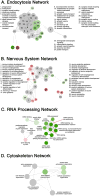The RNA-binding protein caper is required for sensory neuron development in Drosophila melanogaster
- PMID: 28543982
- PMCID: PMC5553308
- DOI: 10.1002/dvdy.24523
The RNA-binding protein caper is required for sensory neuron development in Drosophila melanogaster
Abstract
Background: Alternative splicing mediated by RNA-binding proteins (RBPs) is emerging as a fundamental mechanism for the regulation of gene expression. Alternative splicing has been shown to be a widespread phenomenon that facilitates the diversification of gene products in a tissue-specific manner. Although defects in alternative splicing are rooted in many neurological disorders, only a small fraction of splicing factors have been investigated in detail.
Results: We find that the splicing factor Caper is required for the development of multiple different mechanosensory neuron subtypes at multiple life stages in Drosophila melanogaster. Disruption of Caper function causes defects in dendrite morphogenesis of larval dendrite arborization neurons and neuronal positioning of embryonic proprioceptors, as well as the development and maintenance of adult mechanosensory bristles. Additionally, we find that Caper dysfunction results in aberrant locomotor behavior in adult flies. Transcriptome-wide analyses further support a role for Caper in alternative isoform regulation of genes that function in neurogenesis.
Conclusions: Our results provide the first evidence for a fundamental and broad requirement for the highly conserved splicing factor Caper in the development and maintenance of the nervous system and provide a framework for future studies on the detailed mechanism of Caper-mediated RNA regulation. Developmental Dynamics 246:610-624, 2017. © 2017 Wiley Periodicals, Inc.
Keywords: Drosophila; RNA-binding proteins; alternative splicing; dendrite morphogenesis; locomotor behavior; mechanosensory neurons; neurogenesis; post-transcriptional gene behavior.
© 2017 Wiley Periodicals, Inc.
Figures







References
-
- Ashton-Beaucage D, Udell CM, Gendron P, Sahmi M, Lefrançois M, Baril C, Guenier AS, Duchaine J, Lamarre D, Lemieux S, Therrien M. A functional screen reveals an extensive layer of transcriptional and splicing control underlying RAS/MAPK signaling in Drosophila. PLoS Biol. 2014;12:e1001809. - PMC - PubMed
Publication types
MeSH terms
Substances
Grants and funding
LinkOut - more resources
Full Text Sources
Other Literature Sources
Molecular Biology Databases
Research Materials
Miscellaneous

